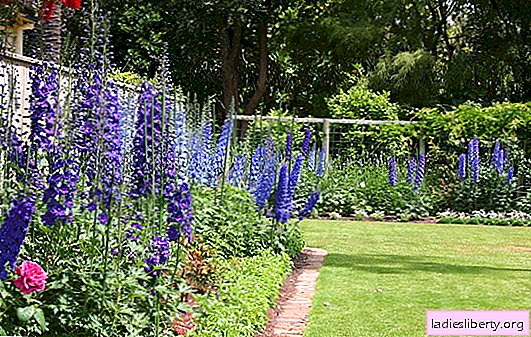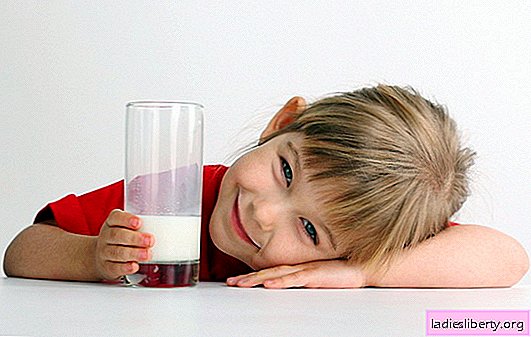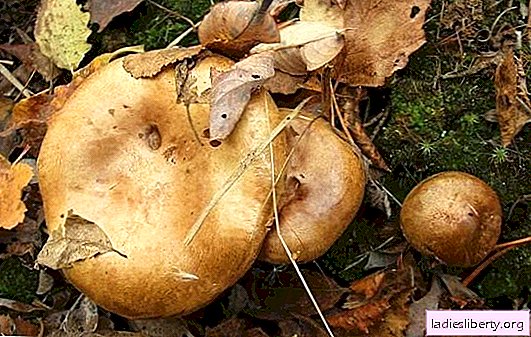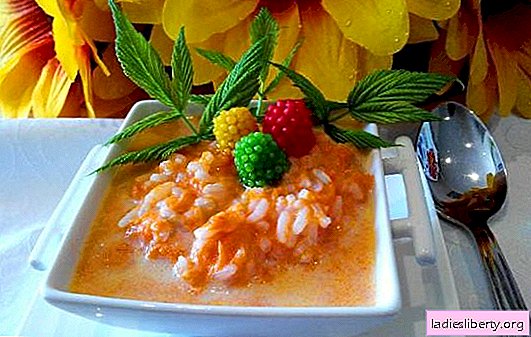
Many gardeners want to plant a delphinium at their summer cottage - planting and caring for this plant are not at all complicated.
This plant is not capricious, but prefers a sunny, and possibly windless, area.
They grow best in fertile and soft soil - loam with a slightly acid reaction is perfect.
Varieties of delphinium
Delphinium is divided into several varieties:
1. Leroy. This variety has its roots in Africa. It has a distinctive sweet smell. Stems with white or light green flowers grow up to one and a half meters.
2. Pyramidal. This type of delphinium descended from the highlands of the Himalayas. It tolerates frosts up to -20 degrees. He loves poor soils with stones. Small (up to 3 cm) inflorescences actively bloom from July to the end of September.
3. Terry. Tall, up to two meters tall plant. A variety of shades have a large inclusion of blue and purple. From May to August, active flowering occurs. This type of delphinium is perennial and has been growing quietly in one place for about 8 years.
4. Rare color. Type of plant from the Altai Territory. Srednerosly, does not grow more than 80 cm.
5. Bruno. This variety prefers a warm, and even hot climate. Successfully growing in India, Pamir, Tibet. But in Russia, the territories of the Krasnodar Territory and Sochi are perfect for him. This species is similar in its flowers to pansies.
6. Tall. This species of plant is a giant in its environment. Its height can exceed three meters. Unfortunately, the trunk of the delphinium is thin and it requires garter every 50 cm.
7. Holostebelny. Srednerosly variety (height does not exceed 1 meter) easily grows in pots. Can be cleaned in the cold season. Flowering begins in late June - early July.
8. Short Spur. Stunted plant. Its height is up to 30 cm. It easily tolerates frosts and blooms with small but plentiful flowers.
Delphinium landing
How to plant and care for the dolphinium is few known. This flower should be planted through seedlings. If planted in open ground - there is little chance that the plant will survive. Before planting, you need to soak the seeds in a solution of manganese. Do not put a lot of powder, the color should be pale pink.
From the soil you need to remove all the roots of weeds and possible insects. When pouring soil into cans for seedlings, gently press it. Spread the seeds on the soil surface, sprinkling on top with a layer no thicker than 4 mm. Spill the seeds with warm, best boiled water and cover with a dark film. Shoots will appear in one and a half - two weeks. After emergence, the film needs to be removed and grown flowers on the sunny side.
Landing in the ground should be done when the average daily temperature does not drop below 13 degrees heat. Plants need to be planted at a distance of 60 cm from each other. In the holes should be poured humus, sifted ash and mix it with the soil. After planting, shed plenty of warm water with warm water.
Dolphin Care
Approximately 1.5-2 weeks after planting the dolphinium in open ground, it must be fertilized. This is carried out with mineral or organic fertilizers, such as, for example, a solution of diluted mullein. Do not forget about nitrogen-type fertilizers, they have an excellent effect on the strength of flowers and the power of foliage. The last time you need to fertilize the plant when the flowering is coming off. This is done so that next year the plant was healthy.
Planting and caring for the dolphinium does not imply daily watering of the plant. This procedure should only be done when there is a dry period of time. When watering, you do not need to touch the leaves with trickles of water, this can cause powdery mildew

When the height of the plant is at least 20 cm, the delphinium needs to be thinned out. It is worth removing the thinnest and smallest plants, leaving two or three large ones. Thanks to this, the inflorescences will be large and powerful

A couple of weeks after thinning, it is already possible to create supports for tying. It is necessary to act carefully - during the clogging of stakes it is very easy to damage the root of the plant. You can tie up the delphinium with a soft braid.
After flowering, if the seeds are not needed, the stems can be cut. Perhaps if the plant is in a warm climate, there will be a second flowering. If the climate is cold, then do not cut the stems. Because of this, water will get into them, since they are hollow inside and rotting of the root space can be caused. These stems will be properly removed in mid-spring.
For winter time, the delphinium does not require additional sheltering of the root, since it is quite resistant to cold.
Dolphinium top dressing
Delphinium during planting and care is very demanding on various kinds of top dressing. Before flowering, you need to feed the plant with a mixture of fertilizers. This composition is simple: 3 tablespoons of azofoska should be put on one bucket of water (if not, 1 tablespoon of superphosphate will be replaced), and one tablespoon of urea and potassium sulfate. Stir everything thoroughly and pour about 3 liters of solution under one bush.
During flowering, another solution is used: a liter of mullein is put on a bucket of water, and about a tablespoon of fertilizer with a complex purpose. Such a solution under the bush should also be poured in the region of three liters.
During the entire growth of the plant should monitor the color of the foliage. If it is light green or grayish in color, it means that the dolphinium lacks nitrogen. In order for the plant to receive this substance, it is necessary to spread the manure in the root area and pour it with plenty of water. With each watering, the plant will receive a fraction of nitrogen.
After flowering has ended, the bush must be fertilized with a solution of substances in which potassium and phosphorus are present. Each product is placed in a tablespoon of 10 liters of water and pour a liter of liquid under one bush. To protect the kidneys, which will bloom next year, you need to take 10 liters of hot water and dilute 2 grams of boric acid in it. Spray the dolphinium with this compound.
Delphinium diseases
There are not many diseases that can affect dolphiniums, but they are. One of the most common is black spotting leaves.

This disease can be caused by cool weather with heavy rainfall. Different sizes of spots appear on the leaves of the plant, which are black in color. On the underside of the leaf, these spots are brown. This disease, as a rule, starts from the roots and goes up the trunk. The bacteria that carry this disease love a warm, moist place. They especially like where the fallen foliage lies. To avoid this trouble, you need to carefully clean the area during preparation for the winter.
There is one more trouble - bacterial wilt. This disease can occur in both cold and hot weather. The first signs of the disease are that the leaves located near the ground turn yellow and dark spots appear on the stem. Their structure is quite softer than the structure of the stem. This disease cannot be cured, but can be prevented. Immediately before planting, the seeds must be placed in water heated to a temperature of 50 degrees, for about half an hour. Wrap a container with a towel so that the water retains heat longer.
Powdery mildew - Another easily occurring type of disease. As soon as the first signs of powdery mildew are noticed, you should immediately spray all the leaves of the plant with a solution of water with cow manure. Be sure to tear the affected leaves from the stem. Powdery mildew, as a rule, affects delphiniums, which have leaves with a smooth surface.
Delphinium fly - This insect lays eggs in flower buds.

After some time, small white larvae develop in the flowers, which are able to gnaw stamens and pistils. Such flowers are not able to produce seeds, and very quickly fall off. These insects survive the winter in the form of pupae near the roots of the plant. To avoid this scourge, during the swelling of the dolphinium buds, they must be sprayed with prometrin. It is added in an amount of 25 - 27 grams per 10 liters of warm water.
Adhering to such knowledge, it is very simple to grow a dolphinium in your garden plot.











